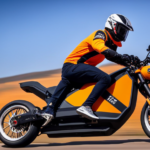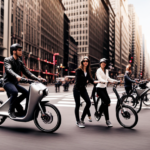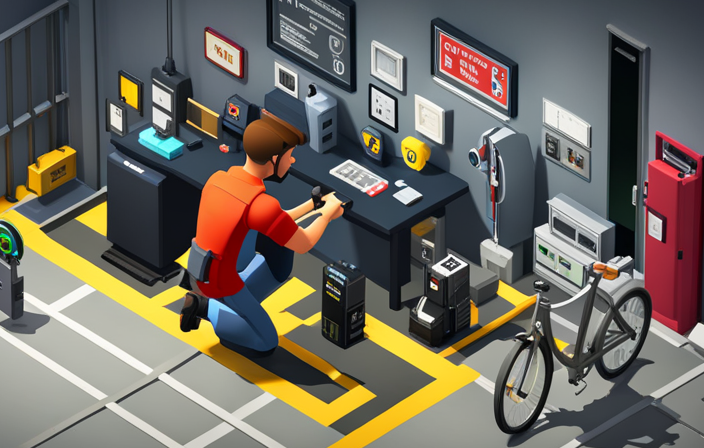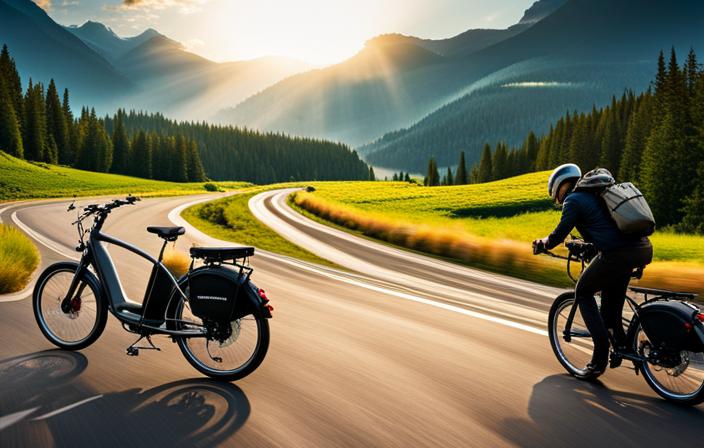In the cycling world, there is a realm where regular bikes go beyond their boundaries and become extraordinary. Just like a simple caterpillar turning into a beautiful butterfly, any bike has the potential to transform into an electric-powered marvel. With the addition of a motor and battery, these bikes gain speed and efficiency, making rides smoother and more enjoyable. This evolution leads many to ask, what are electric bikes and how do they differ from traditional bicycles? Simply put, they are bicycles equipped with electric assistance, helping riders conquer longer distances and challenging terrains with ease.
This article will guide you through the process of turning your beloved bike into an electric bike, unlocking a new level of speed and convenience. Prepare to embark on a journey of technical prowess, as we unveil the secrets to this futuristic transformation.
Key Takeaways
- Troubleshoot and secure the wiring before testing the system
- Adjust and fine-tune the electric bike for optimal performance and efficiency
- Proper maintenance and safety precautions are essential for optimal functioning
- Enhance speed and maximize battery life for a better electric bike experience
Assess Your Bike’s Compatibility
You’ll need to assess if your bike is compatible for conversion into an electric bike.
Before you start any bike modification, it’s crucial to evaluate the frame and components of your existing bike. Firstly, check if your bike has a steel or aluminum frame, as these are the most suitable for electric conversions.
Next, ensure that your bike has enough space to accommodate the battery pack and motor. Additionally, assess the condition of the drivetrain, brakes, and wheels to ensure they can handle the increased weight and power.
It is also important to conduct a cost analysis to determine if converting your bike is financially viable. Consider the expenses of purchasing a conversion kit, battery, and other necessary components.
Once you’ve completed this assessment, you can confidently move on to choosing the right conversion kit.
Choose the Right Conversion Kit
When choosing the right conversion kit for your electric bike, you need to first decide between a front or rear wheel conversion. This choice will depend on your specific needs and preferences.
Next, you should consider the hub motor power and battery range. The power of the motor will determine the speed and performance of your electric bike, while the battery range will determine how far you can travel on a single charge.
Lastly, it is important to select the right battery type, such as a lithium-ion battery, which offers high energy density, longer lifespan, and faster charging times.
Decide Between Front or Rear Wheel Conversion
First, consider whether you want to go with a front or rear wheel conversion for your electric bike. Each option has its own advantages and disadvantages.
A front wheel conversion is easier to install and requires less maintenance, making it a popular choice for beginners. It provides better traction, especially in wet conditions, and is generally more stable. However, it can affect the steering and handling of your bike, making it feel slightly different to ride.
On the other hand, a rear wheel conversion offers better balance and weight distribution. It allows for better control during acceleration and braking, resulting in a smoother ride experience. However, it can be more challenging to install and may require additional modifications to your bike.
Consider these factors when deciding between a front or rear wheel conversion. Now, let’s move on to the next section and consider hub motor power and battery range.
Consider Hub Motor Power and Battery Range
To determine the hub motor power and battery range that best suit your needs, consider factors such as your desired speed and distance traveled.
Calculate power requirements by considering the weight of your bike and your own weight, as well as the terrain you will be riding on. A higher power rating will allow for faster acceleration and better performance on hills.
Determine battery capacity by estimating the distance you plan to travel on a single charge. Keep in mind that larger capacity batteries will provide longer range, but they will also be heavier. It’s important to find a balance between power and range that meets your specific requirements.
Once you have calculated your power requirements and determined the battery capacity you need, you can select the right battery type, such as lithium-ion. This will be discussed in the subsequent section.
Select the Right Battery Type (e.g. Lithium-ion)
The most popular battery type for electric bikes is lithium-ion. Lithium-ion batteries are known for their high energy density, long lifespan, and lightweight design. They are also less prone to memory effect compared to other battery types, meaning you can charge them at any time without reducing their overall capacity. When it comes to battery maintenance, it’s important to regularly check the battery voltage and ensure it’s within the recommended range. Additionally, proper charging techniques are essential for maximizing battery life. Avoid overcharging the battery and always use the charger specifically designed for your lithium-ion battery. Now that you understand the importance of selecting the right battery type and the necessary battery maintenance and charging techniques, you can move on to gathering the necessary tools and equipment for the conversion process.
Gather the Necessary Tools and Equipment
Now, you’ll need to gather all the necessary tools and equipment to turn your bike into an electric one. Here’s a list of items you’ll need:
-
Finding affordable conversion kits: Start by researching and finding the best conversion kit that suits your needs and budget. Look for kits that come with a motor, controller, battery, and all the necessary wiring.
-
Exploring DIY options: If you’re more inclined towards a do-it-yourself approach, gather the necessary components individually. This includes a hub motor, battery pack, controller, throttle, and other electrical components.
-
Wrench set: A good quality wrench set will be essential for removing the bike’s existing wheel and installing the electric hub motor. Make sure to have different sizes to accommodate various bolts and nuts.
-
Bike stand: To make the installation process easier, consider using a bike stand that securely holds your bike in place. This will provide stability and allow you to work comfortably.
With these tools and equipment in hand, you’ll be ready to move on to the next step of removing the bike’s existing wheel and installing the electric components.
Remove the Bike’s Existing Wheel
Start by removing the existing wheel on your bike. This is an important step in the process of turning your bike into an electric one. Before you begin, assess the compatibility of your bike with an electric conversion kit. Take into consideration the frame size, dropout width, and brake type. Once you have determined compatibility, it’s time to choose the right conversion kit for your bike. Consider factors such as motor power, battery capacity, and control system. To grab your attention, here’s a table comparing different conversion kits:
| Conversion Kit | Motor Power | Battery Capacity | Control System |
|---|---|---|---|
| Kit A | 250W | 36V, 10Ah | Pedal Assist |
| Kit B | 500W | 48V, 14Ah | Throttle |
| Kit C | 750W | 52V, 20Ah | Pedal Assist |
Once you have chosen the right kit, you can move on to the next step of installing the electric conversion kit without any hassle.
Install the Electric Conversion Kit
To begin installing the electric conversion kit, you’ll need to remove the existing wheel on your bike. Before you start, make sure you have all the necessary tools and equipment.
First, disconnect the brake cables and release the tension on the derailleur. Then, loosen the axle nuts or quick-release skewer and remove the wheel from the frame. Once the wheel is off, inspect the dropout area for any debris or damage.
Now, it’s time to install the electric conversion kit. Follow the manufacturer’s instructions carefully and ensure that all the components are securely attached. Electric conversion kit installation tips include double-checking the alignment of the motor, properly connecting the wiring, and tightening all bolts.
Common challenges in installing electric conversion kits may include compatibility issues with certain bike frames or difficulties in routing the wiring. Once the kit is installed, you can proceed to the next step of securing the wiring and testing the system.
Secure the Wiring and Test the System
After installing the electric conversion kit, make sure to securely secure the wiring and test the system to ensure everything is functioning properly.
Start by organizing the wires neatly and using zip ties or clips to secure them to the frame. This will prevent any loose wires from getting tangled in the bike’s moving parts.
Next, carefully inspect all the connections to ensure they are properly plugged in and tightened. If you encounter any issues, such as loose connections or faulty wiring, refer to the troubleshooting guide provided with the conversion kit.
Once the wiring is secure, it’s time to test the system. Turn on the electric bike and check if all the components, such as the motor, throttle, and battery, are working as expected. Pay close attention to any abnormal sounds or vibrations.
Additionally, analyze the system’s performance by taking the bike for a short test ride. Observe how smoothly the motor engages and disengages, and if the battery provides adequate power.
If everything is functioning well, you can proceed to the next section about adjusting and fine-tuning the electric bike’s settings.
Adjust and Fine-tune the Electric Bike
Now that you have secured the wiring and tested the system, it’s time to move on to the next step: adjusting and fine-tuning your electric bike. This is where you can really optimize the performance and efficiency of your newly converted bike. By making small adjustments and tweaks, you can ensure that your bike runs smoothly and efficiently.
To help you visualize the adjustments you can make, here is a table showcasing the different aspects of your bike that you can fine-tune:
| Aspect | Adjustment |
|---|---|
| Motor power | Increase or decrease the power output of the motor |
| Battery capacity | Adjust the battery capacity to optimize range |
| Pedal assist level | Fine-tune the level of assistance provided by the motor |
| Braking system | Ensure proper braking performance for safety |
By fine-tuning these aspects, you can tailor your electric bike to your specific needs and preferences. Once you have optimized the performance and efficiency, it’s time to move on to the next section where we will discuss how to ensure proper maintenance and safety.
Ensure Proper Maintenance and Safety
Proper maintenance and safety are essential for the optimal functioning of your converted e-bike.
To ensure the longevity and performance of your electric bike, there are a few maintenance tips you should follow.
Regularly inspect the tires for wear and tear, and keep them properly inflated to ensure a smooth and safe ride.
Check the brakes regularly to ensure they are working effectively, and adjust them if necessary.
Additionally, keep the chain lubricated and clean to prevent rust and ensure smooth pedaling.
When it comes to safety precautions, always wear a helmet and other protective gear while riding your e-bike.
Follow traffic rules and be mindful of your surroundings.
Now that you understand the importance of maintenance and safety, you can fully enjoy the benefits of your electric bike.
Enjoy the Benefits of Your Electric Bike
Get ready to experience all the advantages of your e-bike! To fully enjoy the benefits of your electric bike, it’s important to enhance its speed and maximize the battery life. By implementing these strategies, you can take your electric bike to the next level.
To enhance your electric bike’s speed, you can consider upgrading the motor or controller. Upgrading to a more powerful motor or a higher voltage controller can significantly increase your bike’s top speed. Additionally, optimizing the gear system and reducing friction can also improve the speed and performance of your e-bike.
Maximizing the battery life of your electric bike is crucial for longer rides. You can achieve this by using the appropriate power mode, avoiding excessive acceleration, and maintaining a steady speed. Additionally, keeping the battery charged between 20% and 80% and storing it in a cool, dry place can prolong its lifespan.
To further enhance your electric bike, consider additional upgrades and accessories. These can include installing a suspension fork for a smoother ride, adding fenders for protection against dirt and water, or attaching a cargo rack for extra storage.
Now that you have optimized your e-bike’s speed and battery life, let’s explore the next section on considering additional upgrades and accessories.
Consider Additional Upgrades and Accessories
Consider adding upgrades and accessories to enhance your e-biking experience.
To ensure your safety and improve your ride, upgrading your bike’s brakes is essential. Electric bikes tend to have higher speeds than regular bikes, so investing in hydraulic disc brakes or upgrading your existing brakes to a higher quality will provide better stopping power and control.
Additionally, adding lights to your e-bike is crucial for visibility, especially during low-light conditions or nighttime rides. Look for powerful LED lights that can be easily attached to your handlebars or helmet. These lights will not only illuminate your path but also make you more visible to other road users.
Remember, safety should always be a top priority when riding your electric bike, and these upgrades and accessories will greatly enhance your overall e-biking experience.
Frequently Asked Questions
Can I install an electric conversion kit on a bike that has disc brakes?
Installing an electric conversion kit on a bike with disc brakes should not be a problem if it is compatible. Ensure that the kit is designed for disc brake compatibility and follow the manufacturer’s instructions for proper installation.
How long does it typically take to install an electric conversion kit on a bike?
To install an electric conversion kit on a bike, it typically takes around 1-2 hours. The tools required are a wrench, screwdriver, and Allen wrench set. Follow the manufacturer’s instructions for a successful installation.
Can I still pedal the bike if the electric motor is turned off?
Yes, you can still pedal the bike even if the electric motor is turned off. This allows you to maintain pedaling efficiency and get the benefits of the pedal assist mode when you choose to use it.
Will installing an electric conversion kit void my bike’s warranty?
Yes, installing an electric conversion kit on your bike may void its warranty. The compatibility of the kit with your bike’s components and the potential damage caused are factors to consider.
Are there any weight restrictions for using an electric conversion kit on a bike?
There are generally no weight restrictions for using an electric conversion kit on a bike. The electric conversion kit compatibility allows for easy installation, and the benefits of using it include increased speed and assistance while riding.
Conclusion
Congratulations! You’ve successfully transformed your regular bike into an extraordinary electric bike. By carefully assessing your bike’s compatibility and selecting the right conversion kit, you’ve unlocked a world of convenience and efficiency.
With proper installation, adjustment, and maintenance, your new electric bike will provide you with endless joy and freedom.
Remember, ‘The journey of a thousand miles begins with a single pedal stroke.’ So hop on your electric bike and embark on new adventures, powered by the thrill of the open road.
Safe travels!
















